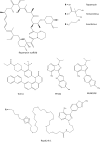Transcription and Translation Inhibitors in Cancer Treatment
- PMID: 32373584
- PMCID: PMC7186406
- DOI: 10.3389/fchem.2020.00276
Transcription and Translation Inhibitors in Cancer Treatment
Abstract
Transcription and translation are fundamental cellular processes that govern the protein production of cells. These processes are generally up regulated in cancer cells, to maintain the enhanced metabolism and proliferative state of these cells. As such cancerous cells can be susceptible to transcription and translation inhibitors. There are numerous druggable proteins involved in transcription and translation which make lucrative targets for cancer drug development. In addition to proteins, recent years have shown that the "undruggable" transcription factors and RNA molecules can also be targeted to hamper the transcription or translation in cancer. In this review, we summarize the properties and function of the transcription and translation inhibitors that have been tested and developed, focusing on the advances of the last 5 years. To complement this, we also discuss some of the recent advances in targeting oncogenes tightly controlling transcription including transcription factors and KRAS. In addition to natural and synthetic compounds, we review DNA and RNA based approaches to develop cancer drugs. Finally, we conclude with the outlook to the future of the development of transcription and translation inhibitors.
Keywords: cancer; drug; inhibitor; transcription; translation.
Copyright © 2020 Laham-Karam, Pinto, Poso and Kokkonen.
Figures









Similar articles
-
Taking Aim at the Undruggable.Am Soc Clin Oncol Educ Book. 2021 Mar;41:1-8. doi: 10.1200/EDBK_325885. Am Soc Clin Oncol Educ Book. 2021. PMID: 33989024
-
KRAS mutation: from undruggable to druggable in cancer.Signal Transduct Target Ther. 2021 Nov 15;6(1):386. doi: 10.1038/s41392-021-00780-4. Signal Transduct Target Ther. 2021. PMID: 34776511 Free PMC article. Review.
-
Targeting KRAS mutant cancers: from druggable therapy to drug resistance.Mol Cancer. 2022 Aug 4;21(1):159. doi: 10.1186/s12943-022-01629-2. Mol Cancer. 2022. PMID: 35922812 Free PMC article. Review.
-
Targeted Protein Degradation: An Important Tool for Drug Discovery for "Undruggable" Tumor Transcription Factors.Technol Cancer Res Treat. 2022 Jan-Dec;21:15330338221095950. doi: 10.1177/15330338221095950. Technol Cancer Res Treat. 2022. PMID: 35466792 Free PMC article.
-
Eliminating oncogenic RAS: back to the future at the drawing board.Biochem Soc Trans. 2023 Feb 27;51(1):447-456. doi: 10.1042/BST20221343. Biochem Soc Trans. 2023. PMID: 36688434 Free PMC article.
Cited by
-
Differential Impact of Random GC Tetrad Binding and Chromatin Events on Transcriptional Inhibition by Olivomycin A.Int J Mol Sci. 2022 Aug 9;23(16):8871. doi: 10.3390/ijms23168871. Int J Mol Sci. 2022. PMID: 36012127 Free PMC article.
-
Formulation, Characterization, and Potential Therapeutic Implications of Encapsulated Recombinant Alpha-luffin in Niosomes.Curr Pharm Biotechnol. 2025;26(6):923-934. doi: 10.2174/0113892010316435240806053230. Curr Pharm Biotechnol. 2025. PMID: 39185643
-
Large tandem duplications in cancer result from transcription and DNA replication collisions.medRxiv [Preprint]. 2024 Jan 10:2023.05.17.23290140. doi: 10.1101/2023.05.17.23290140. medRxiv. 2024. Update in: Nat Cancer. 2024 Dec;5(12):1885-1901. doi: 10.1038/s43018-024-00848-4. PMID: 38260434 Free PMC article. Updated. Preprint.
-
Peruvoside is a novel Src inhibitor that suppresses NSCLC cell growth and motility by downregulating multiple Src-EGFR-related pathways.Am J Cancer Res. 2022 Jun 15;12(6):2576-2593. eCollection 2022. Am J Cancer Res. 2022. PMID: 35812056 Free PMC article.
-
Characterization of the biochemical activity and tumor-promoting role of the dual protein methyltransferase METL-13/METTL13 in Caenorhabditis elegans.PLoS One. 2023 Jun 22;18(6):e0287558. doi: 10.1371/journal.pone.0287558. eCollection 2023. PLoS One. 2023. PMID: 37347777 Free PMC article.
References
Publication types
LinkOut - more resources
Full Text Sources
Other Literature Sources
Research Materials
Miscellaneous

